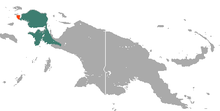| Western long-beaked echidna[1] | |
|---|---|
 | |
| Scientific classification | |
| Kingdom: | Animalia |
| Phylum: | Chordata |
| Class: | Mammalia |
| Order: | Monotremata |
| Family: | Tachyglossidae |
| Genus: | Zaglossus |
| Species: | Z. bruijnii |
| Binomial name | |
| Zaglossus bruijnii | |
 | |
| Western long-beaked echidna range (green — extant, orange — possibly extinct) | |
| Synonyms | |
Zaglossus bruijnii (Peters & Doria, 1876) [orth. error] | |
The western long-beaked echidna (Zaglossus bruijnii) is one of the four extant echidnas and one of three species of Zaglossus that occur in New Guinea. Originally described as Tachyglossus bruijnii, this is the type species of Zaglossus.
Description[edit]
The western long-beaked echidna is an egg-laying mammal. Unlike the short-beaked echidna, which eats ants and termites, the long-beaked species eats earthworms. The long-beaked echidna is also larger than the short-beaked species, reaching up to 16.5 kilograms (36 lb); the snout is longer and turns downward; and the spines are almost indistinguishable from the long fur. It is distinguished from the other Zaglossus species by the number of claws on the fore and hind feet: three (rarely four). It is the largest extant monotreme.[3]
Distribution and habitat[edit]
The species is found in the Bird's Head Peninsula and Foja Mountains of West Papua and Papua provinces, Indonesia, respectively, in regions of elevation between 1,300 and 4,000 metres (4,300 and 13,100 ft); it is absent from the southern lowlands and north coast. Its preferred habitats are alpine meadow and humid montane forests.[2]
A re-examination of a specimen in the British Museum (Tring collection), noted as collected at a site in the Kimberley region of north-west Australia, was identified as this species. The skin and skull is labelled as part of the material collected by John T. Tunney on an expedition through that region in the 1930s. If accurate it is evidence of a species thought to be have been extinct for millennia in Australia; the only records up to that time of Zaglossus was of fossils dated to the Pleistocene period. The conclusion of the authors, supported by evidence from Aboriginal elders of the region and similar habitat to Papuan population, was that this species ought to be recognised in the state's fauna as persisting into the modern era and may be extant in a poorly surveyed area of the region.[4]
Conservation[edit]
The species is listed as Critically Endangered by the IUCN; numbers have decreased due to human activities including habitat loss and hunting. The long-beaked echidna is considered a delicacy, and although commercial hunting of the species has been banned by the Indonesian and Papua New Guinean governments, traditional hunting is permitted.[2] In January 2013, an expedition led by Conservation International reported finding a population of the mammals as part of what they described as a "lost world" of wildlife in the Foja Mountains of Papua Province, Indonesia.[5] A specimen collected in 1901 by John T. Tunney, later identified by Helgen et al. (2012), might prove that, in addition to New Guinea, the species inhabited the northern part of Western Australia (Kimberley) at least as recently as the beginning of the 20th century.[6]
References[edit]
- ^ Groves, C.P. (2005). "Order Monotremata". In Wilson, D.E.; Reeder, D.M (eds.). Mammal Species of the World: A Taxonomic and Geographic Reference (3rd ed.). Johns Hopkins University Press. p. 2. ISBN 978-0-8018-8221-0. OCLC 62265494.
- ^ a b c Leary, T.; Seri, L.; Flannery, T.; Wright, D.; Hamilton, S.; Helgen, K.; Singadan, R.; Menzies, J.; Allison, A.; James, R.; Aplin, K.; Salas, L.; Dickman, C. (2016). "Zaglossus bruijnii". IUCN Red List of Threatened Species. 2016: e.T23179A21964204. doi:10.2305/IUCN.UK.2016-2.RLTS.T23179A21964204.en.
- ^ <http://rarestzoo.blogspot.com/2006/07/long-beaked-echidna.html>
- ^ Helgen, Lauren; Kohen, James; Miguez, Roberto Portela; Helgen, Kristofer M. (28 December 2012). "Twentieth century occurrence of the Long-Beaked Echidna Zaglossus bruijnii in the Kimberley region of Australia". ZooKeys. 255: 103–132. doi:10.3897/zookeys.255.3774. ISSN 1313-2970. PMC 3560862. PMID 23459668.
- ^ ‘Lost World’ of wildlife found - World environment - nbcnews.com
- ^ Kristofer M. Helgen; Roberto Portela Miguez; James Kohen & Lauren Helgen (2012). "Twentieth century occurrence of the Long-Beaked Echidna Zaglossus bruijnii in the Kimberley region of Australia". ZooKeys (255): 103–132. doi:10.3897/zookeys.255.3774. PMC 3560862. PMID 23459668.
Further reading[edit]
| Wikimedia Commons has media related to Zaglossus bruijnii. |
| Wikispecies has information related to Zaglossus bruijnii. |
- Augee, M and Gooden, B. 1993. Echidnas of Australia and New Guinea. Australian National History Press ISBN 978-0-86840-046-4
- Flannery T.F., Groves C.P. (1998). "A revision of the genus Zaglossus (Monotremata, Tachyglossidae), with description of new species and subspecies". Mammalia. 62 (3): 367–396. doi:10.1515/mamm.1998.62.3.367.
